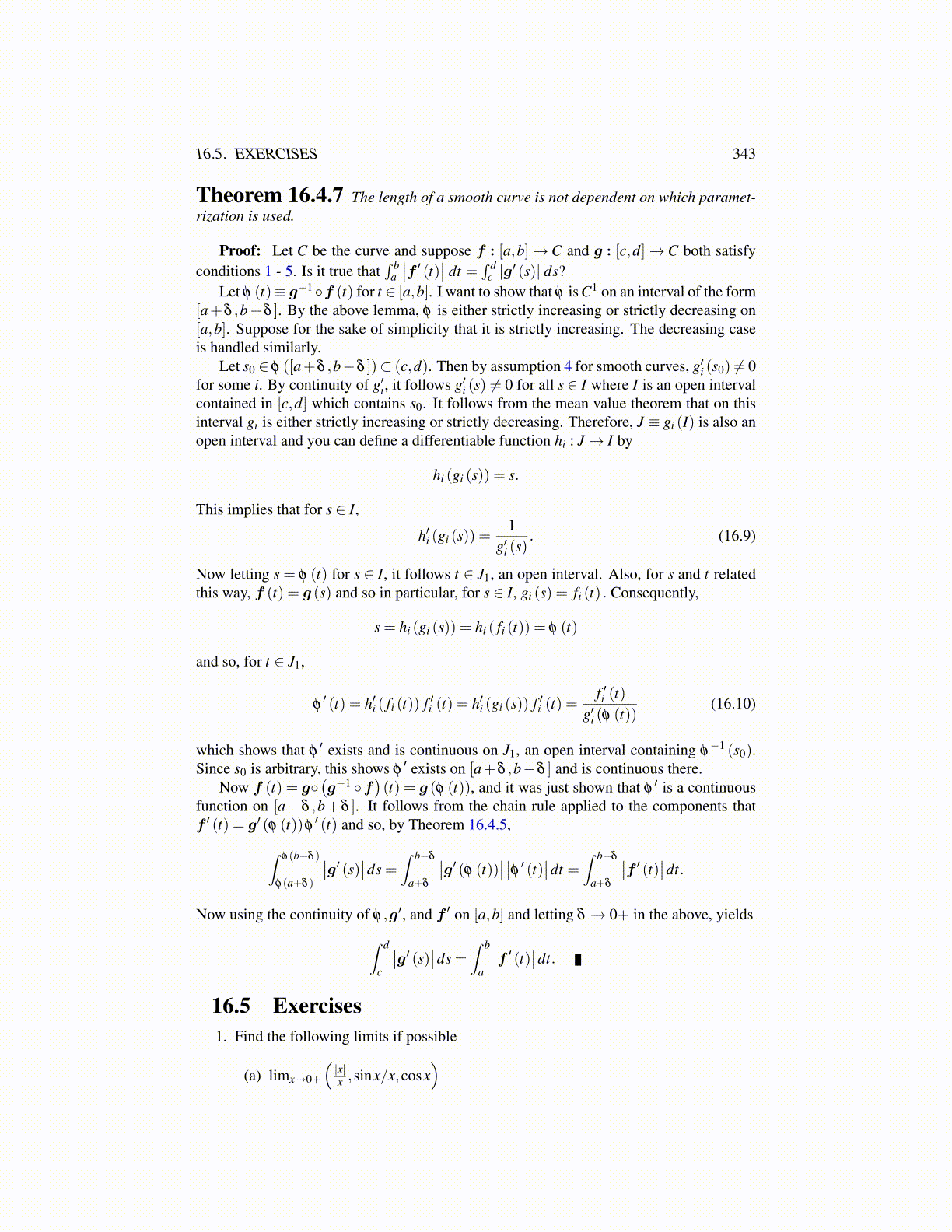
16.5. EXERCISES 343
[a,b]. Suppose for the sake of simplicity that it is strictly increasing. The decreasing caseis handled similarly.
Let s0 ∈ φ ([a+δ ,b−δ ])⊂ (c,d). Then by assumption 4 for smooth curves, g′i (s0) ̸= 0for some i. By continuity of g′i, it follows g′i (s) ̸= 0 for all s ∈ I where I is an open intervalcontained in [c,d] which contains s0. It follows from the mean value theorem that on thisinterval gi is either strictly increasing or strictly decreasing. Therefore, J ≡ gi (I) is also anopen interval and you can define a differentiable function hi : J → I by hi (gi (s)) = s. Thisimplies that for s ∈ I,
h′i (gi (s)) =1
g′i (s). (16.9)
Now letting s = φ (t) for s ∈ I, it follows t ∈ J1, an open interval. Also, for s and t relatedthis way, f (t) = g (s) and so in particular, for s ∈ I, gi (s) = fi (t) . Consequently,
s = hi (gi (s)) = hi ( fi (t)) = φ (t)
and so, for t ∈ J1,
φ′ (t) = h′i ( fi (t)) f ′i (t) = h′i (gi (s)) f ′i (t) =
f ′i (t)g′i (φ (t))
(16.10)
which shows that φ′ exists and is continuous on J1, an open interval containing φ
−1 (s0).Since s0 is arbitrary, this shows φ
′ exists on [a+δ ,b−δ ] and is continuous there.Now f (t) = g◦
(g−1 ◦f
)(t) = g (φ (t)), and it was just shown that φ
′ is a continuousfunction on [a−δ ,b+δ ]. It follows from the chain rule applied to the components thatf ′ (t) = g′ (φ (t))φ
′ (t) and so, by Theorem 16.4.5,∫φ(b−δ )
φ(a+δ )
∣∣g′ (s)∣∣ds =∫ b−δ
a+δ
∣∣g′ (φ (t))∣∣ ∣∣φ ′ (t)
∣∣dt =∫ b−δ
a+δ
∣∣f ′ (t)∣∣dt.
Now using the continuity of φ ,g′, and f ′ on [a,b] and letting δ → 0+ in the above, yields∫ d
c
∣∣g′ (s)∣∣ds =∫ b
a
∣∣f ′ (t)∣∣dt.
16.5 Exercises1. Find the following limits if possible
(a) limx→0+
(|x|x ,sinx/x,cosx
)(b) limx→0+
(x|x| ,secx,ex
)(c) limx→4
(x2−16x+4 ,x+7, tan4x
5x
)(d) limx→∞
(x
1+x2 ,x2
1+x2 ,sinx2
x
)2. Find limx→2
(x2−4x+2 ,x
2 +2x−1, x2−4x−2
).
3. Prove from the definition that limx→a ( 3√
x,x+1) = ( 3√
a,a+1) for all a ∈ R. Hint:You might want to use the formula for the difference of two cubes,
a3 −b3 = (a−b)(a2 +ab+b2) .